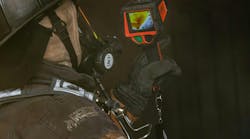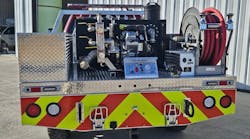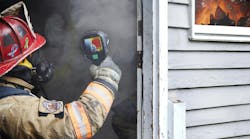As the benefits of thermal imaging have become more well-known, many fire departments have prioritized funding for thermal imagers or sought grant assistance to obtain the devices. Couple this with advances in technology that have brought the price of a basic thermal imager to under $5,000, and most departments that want thermal imagers have been able to buy them. However, this perceived ubiquity of the technology makes it easy to forget just how much of the nation’s fire service remains almost completely unfunded.
Even in 2013, a remarkably high number of U.S. fire departments receive absolutely no outside funding. It is a sad reality, but the fact remains that fundraising is the backbone of many departments. In some departments, firefighters pay out of their own pockets simply to put fuel in the trucks.
Raising funds for imagers
Among all of the products fire departments may buy with fundraising dollars, thermal imagers are perhaps the most valuable and compelling. No other piece of equipment will do as much to save lives. This column offers tips for communities raising funds for thermal imagers.
• Build your team – Don’t attempt to do everything yourself. Build a team and assign responsibilities to team members. Use the individual skills of fire department members and any interested community members to build the competency you need to run an effective campaign. At a minimum, you will need to fill the roles of campaign manager, campaign spokesperson, promotions/media relations manager, event manager and contribution manager.
• Establish a plan – Major decisions about your campaign should be made at the first team meeting, with members receiving initial assignments before they leave. Use this meeting to identify your target audience, outline your message, determine your goal, establish your fundraising tactics and decide on communications tools.
In small communities your audiences could be the public, civic organizations, businesses and local government. When considering how to communicate your message, first think about what will motivate your audiences to give. For example, if your department protects a rural area, discuss with potential donors that thermal imaging will not only greatly assist with structure fires, but the technology can also help you find children or ejected accident victims lost in fields or wooded areas. If your department is in a farming community, discuss the use of thermal imagers in fighting silo fires. If you are appealing to a local business for support, talk about how thermal imaging would assist in managing an incident at their facility.
• Conduct a kickoff demonstration – It is likely that most members of your audience do not clearly understand the challenges you face on the job. Your campaign kickoff demonstration must let potential donors see for themselves what you do and how thermal imagers can positively impact your work. Communities around the country have launched campaigns by simulating search and rescue situations with non-toxic smoke and volunteer victims. Plan the details carefully and invite as many people in your target audience as possible. Ideally, this event will let potential donors and media members experience the difficulty of searching in smoke versus the ease of searching with a thermal imager.
• Involve the media – Regardless of how you decide to raise funds, the media can be a powerful ally in getting the word. Involve newspapers, radio stations, TV stations and websites that cover news in your community. And, don’t forget social media. Be proactive and create a Facebook page.
Before you kick off the campaign, ask a key local reporter to visit you and become familiar with thermal imaging and what you are attempting to achieve. A feature article published before your launch is a great way to get the public interested and involved in your effort. To increase coverage during your campaign, submit event photos and captions to your local newspaper to get the word out even if media members can’t attend your event. Be sure to actively manage publicity for your largest donors by communicating their contributions through the media.
Fundraising appeals
With a well-oiled plan, your thermal imaging campaign should move along quickly. At any event you hold try to include a technology demonstration, whether it is with an actual thermal imager, a PowerPoint presentation or a video. Offer potential donors a simple handout that explains the benefits of thermal imaging in your community and requests their donation. Fundraising appeals should be diverse and frequent:
• Make an official appeal to your local budgeting authority. Ask it to pay for half of the cost of a thermal imager if it can’t pay the full amount. Show them you’re working hard to raise the rest of the money.
• Set up booths at community events to help the public understand what thermal imagers are and what they do.
• Make presentations to local civic clubs and/or community centers that have funds for local projects.
• Send a fundraising letter to the people you protect. If you have a local story you can share about how thermal imaging has made a difference (in a neighboring department, for example) or how it could have made a difference (the recent loss of a building in your community, for example), share that story in your materials to bring your message home. Use photos to illustrate your points.
Here are a few fundraising event ideas for your community:
• Photo fundraiser at fire department, with portrait sessions held at your firehouse
• Sale of adult and children’s T-shirts that feature your department logo
• Holiday-time event at a local public building, such as Thanksgiving dinner, New Year’s dance or Halloween haunted house
• Auction of donated products and services from local merchants
• “Share the pot” cash raffle (check state and local laws)
• Collaborative event with a local business, such as a special meal at a local restaurant or a bowling tournament at a local bowling alley
• Sale of concessions at high school sporting events
• Retired apparatus auction
Other funding options for thermal imagers include:
• Consult your state or regional EMS office. Federal and state grants, low-interest loans and matching grants may be available to help you buy equipment
• Assistance to Firefighters Grants
• U.S. Department of Agriculture loans and grants to rural communities
• Consider leasing when the purchase price can be spread over three to five years
Conclusion
The cost of thermal imagers has dropped significantly in the last several years, lowering the barrier to buying this valuable tool. Departments that might have previously seen the price as prohibitively high may now find the purchase price far more reasonable.
As your fire department initiates fundraising activities, don’t limit yourselves to one funding source or one funding approach. Build a team of dedicated people who are focused on the goal and show potential donors how thermal imagers work to save lives, preserve property and keep firefighters safe on the job. With a determined, organized and passionate team, it’s within your reach to get equipped with thermal imagers, regardless of the size of your community.






